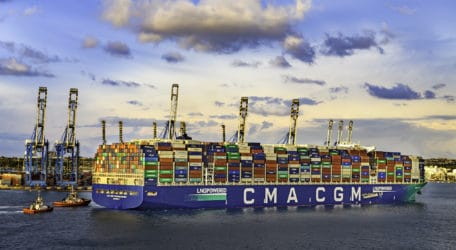
Freeport selected for prestigious super container ship route powered by LNG
Pictured above: The world’s first LNG-powered super containership, CMA CGM Jacques Saade, calling at Malta Freeport on its maiden voyage in October 2020
Malta Freeport Terminals has been selected to be among the weekly ports of call for CMA CGM’s super containerships powered by Liquefied Natural Gas, which emits up to 20 per cent less CO2 when compared with conventional fuel-powered systems.
The vessels will include the CMA CGM Jacques Saade, which became the world’s largest LNG-powered containership when it was launched last October.
The first in a new CMA CGM fleet of more environmentally-friendly super container ships, the Jacques Saade – which had called at the Freeport during its maiden voyage in a symbolic gesture – spans the length of four football pitches and has capacity for 23,000 TEU containers.
Freeport CEO Alex Montebello said: “We are delighted to be among the few ports selected for the prestigious French Asia Line Service connecting Europe to Asia.

“Malta Freeport is only able to attract business of this nature because of the strategic decision we had taken to invest in six megamax quay cranes, which have the capability to stack rows 11-containers-high onto these huge ships.”
The Freeport recently took delivery of components for its last two megamax cranes, ordered from leading manufacturers Liebherr Container Cranes at a cost of €20 million, which will be assembled on site and installed by the summer. Featuring an outreach of 72m, an air draft of 54m and twin-lift spreader capability, this is the only equipment able to service modern super container vessels.
CMA CGM – a shareholder in Malta Freeport Terminals – has commissioned a total of nine super LNG-powered containerships, demonstrating the Group’s resolve to champion the energy transition in the shipping sector and become carbon-neutral by 2050. All these ships will be calling at Malta.
The facility handled 2.4 million containers last year, with 131,000 containers related to local imports or exports.
- February 9, 2021 No comments Posted in: Press Launches Tags: Freeport




